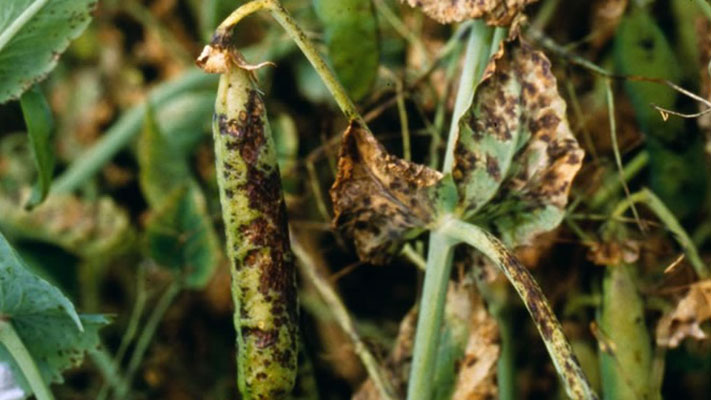Black spot
Elsinoe ampelina (grapes - anthracnose), Alternari solani (tomatoes, capsicums and potatoes - target spot or early blight), Venturia inaequalis (apple and pears - apple and pear scab), Guignardia citricarpa (citrus), Xanthomonas campestris (mangoes - bacterial black spot), Phoma medicaginis var. pinodella, Ascochyta pisi (field peas - black spot complex)
A number of horticultural crops are challenged by black spot, which is also referred to by a number of names. It affects grapes where it is also known as anthracnose. Black spot affects apples and pears and is also known as apple scab and pear scab. In mangoes, black spot is caused by a bacteria rather than a fungus and is referred to as bacterial black spot. In broadacre, field peas are also affected by black spot.

Refer to the links below for more detailed information on black spot in each crop.
Description
With the exception of mangoes, black spot survives as sclerotia from the previous season’s infection and most commonly infects younger leaves and stems. Its development is most common in spring after rain which allows the fungal spores to spread and cause surface infection. In all instances, brown to black lesions result which can affect yield and fruit quality.
Control
Black spot is best managed by implementing a number of preventative measures to reduce the impact of the initial infection rather than trying to control the disease curatively. For each crop preventative measures differ, but will include;
- Planting of disease-free seed
- Rotate crops
- Prune trees or vines to remove disease and improve air flow
- Practice good orchard hygiene i.e. sterilise pruning tools, remove diseased fruit
- Remove infected leaf litter and plant material
- Apply preventative sprays.
References
Agriculture Victoria (2010), ‘Black spot of grapevines, http://agriculture.vic.gov.au/agriculture/pests-diseases-and-weeds/plant-diseases/grapevines/black-spot-of-grapevines
Doepel, R (1960), ‘Black spot of tomatoes, Journal of the Department of Agriculture, Western Australia, Series 4: Vol. 1 : No. 5 , Article 4,
https://researchlibrary.agric.wa.gov.au/cgi/viewcontent.cgi?referer=https://www.google.com/&httpsredir=1&article=1716&context=journal_agriculture4
Herbiguide (Viewed October 2019) ‘Target Spot of Potato, Tomato and Capsicum’,
http://www.herbiguide.com.au/Descriptions/hg_Target_Spot_of_Potato_Tomato_and_Capsicum.htm
Pestnet (Viewed October 2019), ‘Pacific Pests and Pathogens - Fact Sheets: Mango bacterial black spot (213)’, http://www.pestnet.org/fact_sheets/mango_bacterial_black_spot_213.htm
Pitkethley, R (2006), ‘Agnote: Bacterial Black Spot of Mangoes’, Department of Primary Industry, Fisheries and Mines, https://dpir.nt.gov.au/__data/assets/pdf_file/0016/233611/605.pdf
Taylor, A and Gordon, C (2019), ‘Black spot of grapevines in Western Australia’, Department of Primary Industries and Regional Development (DPIRD).










